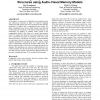Free Online Productivity Tools
i2Speak
i2Symbol
i2OCR
iTex2Img
iWeb2Print
iWeb2Shot
i2Type
iPdf2Split
iPdf2Merge
i2Bopomofo
i2Arabic
i2Style
i2Image
i2PDF
iLatex2Rtf
Sci2ools
MM
2000
ACM
2000
ACM
Determining computable scenes in films and their structures using audio-visual memory models
In this paper we present novel algorithms for computing scenes and within-scene structures in films. We begin by mapping insights from film-making rules and experimental results from the psychology of audition into a computational scene model. We define a computable scene to be a chunk of audio-visual data that exhibits long-term consistency with regard to three properties: (a) chromaticity (b) lighting (c) ambient sound. Central to the computational model is the notion of a causal, finite-memory model. We segment the audio and video data separately. In each case we determine the degree of correlation of the most recent data in the memory with the past. The respective scene boundaries are determined using local minima and aligned using a nearest neighbor algorithm. We introduce the idea of a discrete object series to automatically determine the structure within a scene. We then use statistical tests on the series to determine the presence of dialogue. The algorithms were tested on a d...
| Added | 01 Aug 2010 |
| Updated | 01 Aug 2010 |
| Type | Conference |
| Year | 2000 |
| Where | MM |
| Authors | Hari Sundaram, Shih-Fu Chang |
Comments (0)

